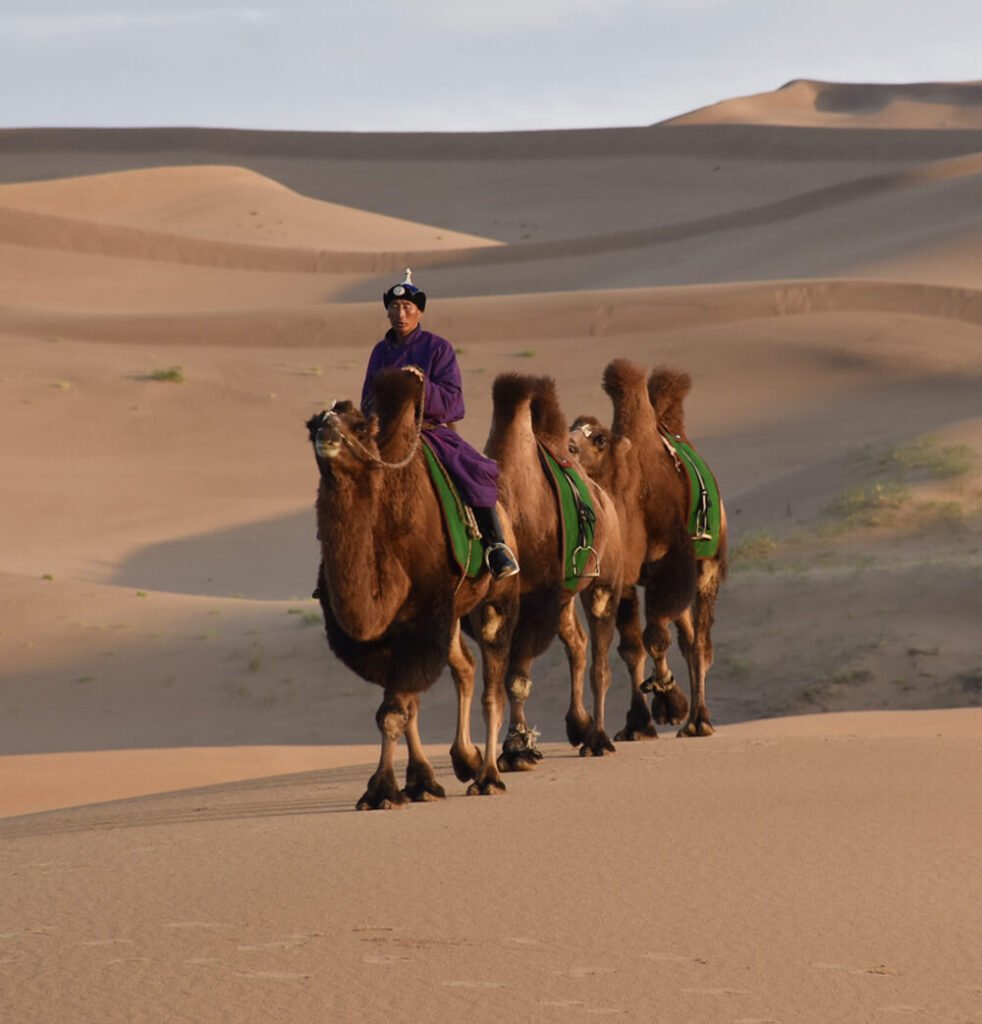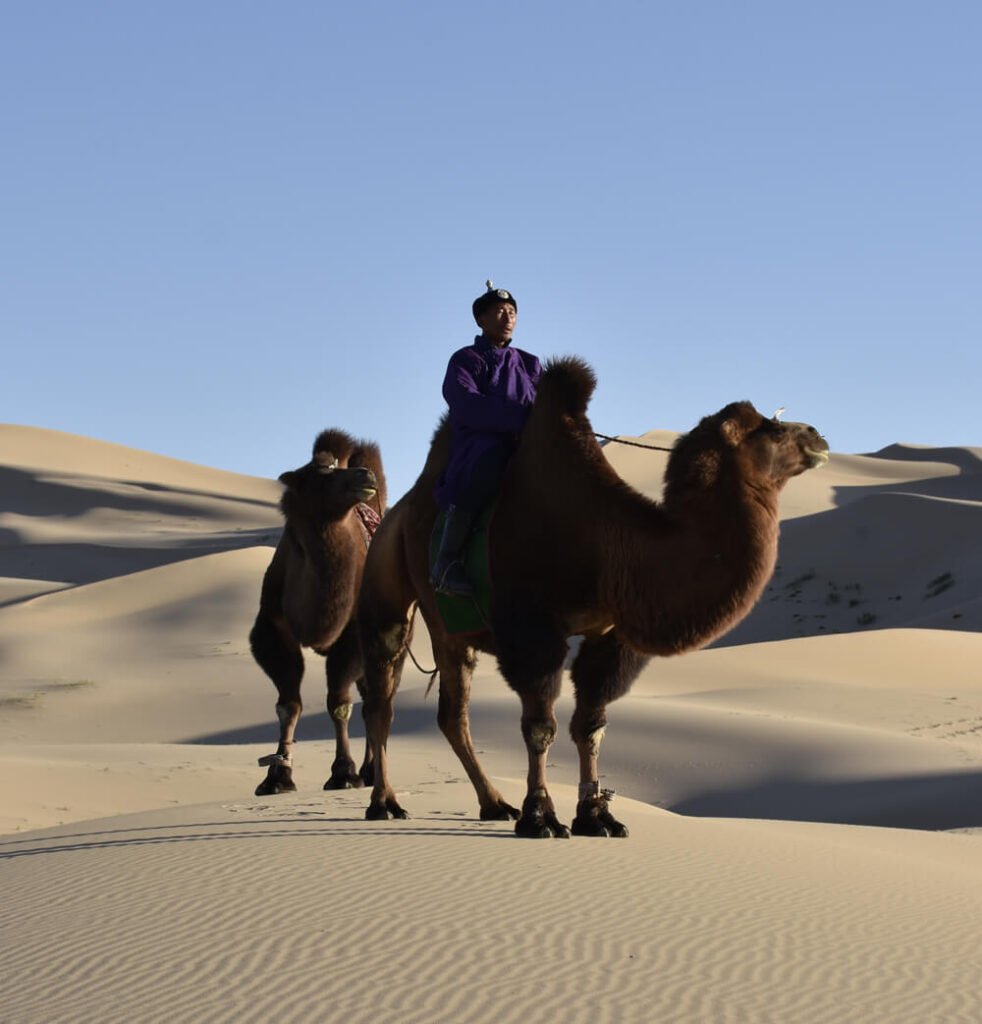Mongolia is most famous for its vast untouched nature; virgin purity and boundless open spaces. The country’s greatest natural attraction is the Gobi Desert, which envelops Mongolia with a sand arc from the Altai and Tien Shan mountains along the border with China to the Nanshan and Altıntag mountains and the Yellow River.
The Gobi is amazing in its size: its area is 1.5 million square meters. km, and in these vast expanses there are a lot of interesting things to experience.
The population density here is approximately 0.28 people per square kilometer. That is, you will calmly drive a couple of hundred kilometers without meeting a single settlement. At the same time, many small villages will be marked on the map, most of which turn out to be migratory camps of just two or three yurts.
“Gobi” is translated from the Mongolian name for desert means “waterless place.” Over the 65 million years of the Gobi’s existence, practically nothing has changed here, except that the wind, shifting the sand dunes grain by grain, extracts the fossilized bones of ancient dinosaurs to the surface.

The remains of prehistoric dinosaurs were found in the Gobi desert at the beginning of the 20th century by scientists from the American Museum of Natural History, who were looking for evidence of the theory that Central Asia is the cradle of human civilization. The fossilized bones, dinosaur eggs and their nests helped to uncover many scientific mysteries about how these ancient dinosaurs lived and how they raised their offspring.

Parts of the Gobi desert are still untouched by man; there are areas where humans have never disturbed its sands. The border between the two worlds lies along the Nemagata depression, except for specially equipped scientific groups or brave travelers.
The Mongols have divided the Gobi Desert into 33 sectors, although it is difficult for a person who is not familiar with it to understand and imagine. 33 small deserts inside one huge Gobi differ in structure types, types of vegetation and colors; there are flowering steppe plains, picturesque cliffs, clay and rocky hammads, vast hollows, saxaul groves, rare green oases, salt marshes and other diverse landscapes.
One of the most amazing deserts in the world, the Gobi is painted and sculpted by the forces of nature from transparent yellow sands, salt marshes and rocks, vibrating red-hot air and a buzz of silence. In fact, the sandy part of the Gobi accounts for only 3% of the entire desert, the rest of its expanses show mesmerizing landscapes of clay and stone where many specially adapted animals and plants also live.
https://mongolia-altai-adventure.com/tours-destinations/gobi-desert/
Black-tailed gazelles and gobian brown bears, wolves, saigas and camels live in different places of the desert – all of them managed to adapt to difficult life in the vast expanses of the desert. In the Gobi there are also mountain rams-argali, kulans, zerens and gazelles that are unique to the region.
The Gobi Desert attracts brave and enthusiastic travelers from all over the world with its mysteriousness, staggering age, many secrets and legends hidden in it. Many scientific and research expeditions are sent here, and tourists travel on all kinds of transport including confident and safe jeeps to horses and bactrian camels. Thanks to its wild beauty, preserved traces of the ancient inhabitants of the planet and the ruins of the greatest Mongol empire, the Gobi remains one of the most important and interesting sights of Mongolia.
Today we will drive on a dust road about 180 km until we reach the biggest sand dunes of Southern Mongolia. We are going to stay with a nomadic family, which means you can observe the Gobi people’s traditional lifestyle up close. Lunch will be prepared by a nomad family. After lunch you can ride a camel around camp. After dinner you can try to climb the highest part of the sand dunes. Khongoryn Els also called Duut Mankhan is popularly known as the “Singing Sands”.
It lies within the Gobi Gurvansaikhan National Park in Mongolia. The sand dunes extend to over 965 square kilometres (373 sq mi) area.
Include
These mountains with granite stone massifs are located in Dund Gobi Province. Baga Gazriin Chuluu, is a 15km long and 10 km wide stone massif, is located 30 km to the south east of Adaatsag village. The highest point is Tahilgat Mountain /1768 m/ in the Northwest part of the stone massif.
Over 20 kinds of medical herbs and many species of animals such as wild sheep, ibex and marmot exist here, Surtiin am is one of many beautiful places in Baga gazriin stone massif.
Include
The weather condition
Mongolia is landlocked and has an extreme continental climate. Summers are hot and dry sometimes with occasional rain, the temperature can fluctuate as much as 20 degrees Celsius between day and night.
Sometimes unpredictable weather can occur in mountain areas. We should be ready for any weather conditions.
What to take along
Waterproof clothes, long underwear for travel in the high mountains, sunscreen, a hat, comfortable footwear, lip balm, sanitary hand wipes, sunglasses, prescription medications, Binoculars, flashlight.
Transport
4×4 drive car with an experienced driver will take us to the National Park and will pick us up on the way back. We’ll hire local herdsmen with his animals, while we are trekking and camping. The tour supplies and gear will be loaded to the Bactrian camels. The camel handler will lead our caravan for a few days till we meet our car.
Staff
Most of our tour will be guided by Erlan and an assistant guide. Erlan has been leading this kind of tour for 10 years and he speaks English, Russian, Mongolian, and Kazakh. Also, our team cook will follow with the assistant cook. Herdsmen follow us only when we are riding.
Food & Meal
Our cooks are excellent at preparing meals. There always will be vegetables available. For vegetarians, our cooks can make food with advanced notice. Every day you will have fresh hot meals for breakfast and dinner. The exception will be lunch, while we are riding. Lunch will be prepared in boxes with snacks and taken with us. We can also cook any special food you wish to bring along.
Includes
English speaking guide, food (3 times per day), cook, packing horse or camels, all overnights in gers and tents, camping and cooking equipment, all local transport ULN-ULG-ULN domestic flight tickets, Border and National park permits.
Excludes
Alcoholic drinks, single hotel room night, International flight tickets.


Lorem ipsum dolor sit amet, consectetur adipisicing elit, sed do eiusmod tempor incididunt ut labore et dolore magna aliqua.
We believe in old-fashioned values and being yourself, so we will only tell the truth about who we are. Our travel agency " Sayat Travel" is an eco-friendly and professional small team built on the service foundations of reliability and honesty, and delivering authentic unforgettable experiences for our guests.
We believe that our guests should receive the most convenient and tailored tour plan suited for them, and we strive to ensure all concerns and discomforts are minimized. We guarantee our tourists an individual approach and quality service at every step.
We believe in old-fashioned values and being yourself, so we will only tell the truth about who we are. Our travel agency " Sayat Travel" is an eco-friendly and professional small team built on the service foundations of reliability and honesty, and delivering authentic unforgettable experiences for our guests.
We believe that our guests should receive the most convenient and tailored tour plan suited for them, and we strive to ensure all concerns and discomforts are minimized. We guarantee our tourists an individual approach and quality service at every step.
Destinations
Contact Us